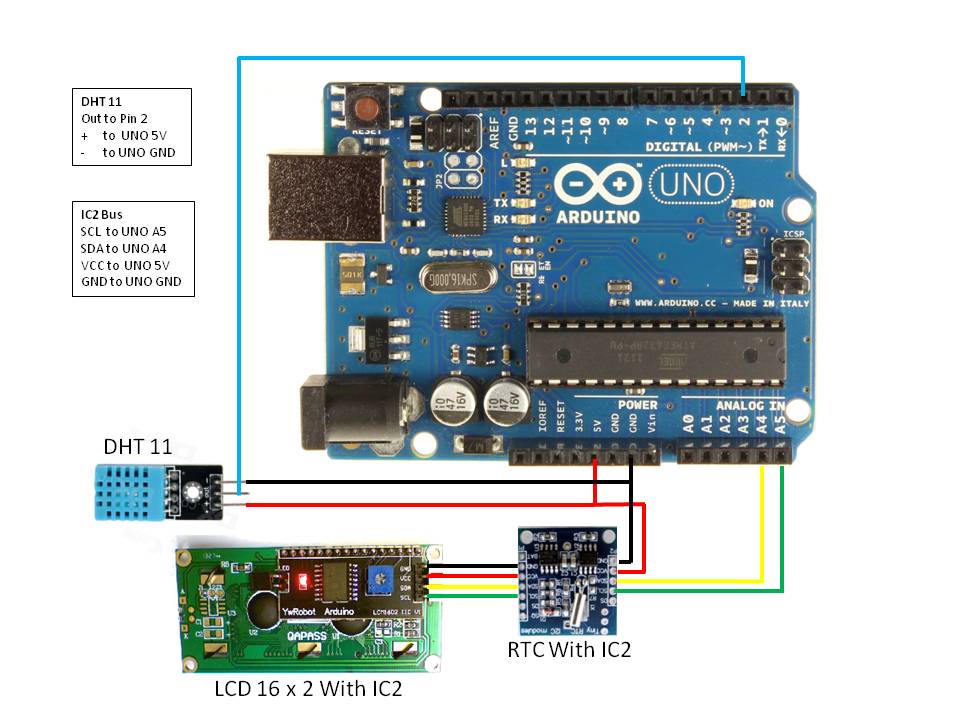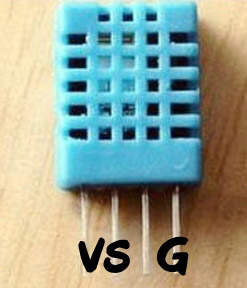
- Humidity measuring accuracy: 5.0% RH
- Temperature measurement accuracy: 2.0 C
- Response time: (Updated by Rob Tillaart: now < 50 ms)
- Low power consumption
Features
.. single wire digital interface ( the most simple system integration, ultra-low prices )
.. ultra-small size ( 12X15.5X5.5 mm )
.. high reliability
.. optimized long-term stability
Test Software Sketch for DHT11 (Credits: THANKS to Rob Tillaart)
DETAILS: Before you can use an "Arduino Software Library", you must make it available by copying it into the correct "libraries" folder. See Libraries HowTo HERE
Here is a .ZIP file for the newest Rob Tillaart version (recommended): media:DHTNEW.zip
NOTE: Lots of good information about the DHT software library on the Arduino "Playground" site HERE.
NOTE: After you install the DHTLIB Library, look in EXAMPLES for similar test sketches for DHT21, DHT22
NOTE: Set your Serial Monitor(click for Info) to 115200 (Lower right of window)
//
// FILE: dht11_test.ino
// AUTHOR: Rob Tillaart
// VERSION: 0.1.01
// PURPOSE: DHT library test sketch for DHT11 && Arduino
// URL:
//
// Released to the public domain
//
#include <dht.h>
dht DHT;
#define DHT11_PIN 5
void setup()
{
Serial.begin(115200);
Serial.println("DHT TEST PROGRAM ");
Serial.print("LIBRARY VERSION: ");
Serial.println(DHT_LIB_VERSION);
Serial.println();
Serial.println("Type,\tstatus,\tHumidity (%),\tTemperature (C)");
}
void loop()
{
// READ DATA
Serial.print("DHT11, \t");
int chk = DHT.read11(DHT11_PIN);
switch (chk)
{
case DHTLIB_OK:
Serial.print("OK,\t");
break;
case DHTLIB_ERROR_CHECKSUM:
Serial.print("Checksum error,\t");
break;
case DHTLIB_ERROR_TIMEOUT:
Serial.print("Time out error,\t");
break;
case DHTLIB_ERROR_CONNECT:
Serial.print("Connect error,\t");
break;
case DHTLIB_ERROR_ACK_L:
Serial.print("Ack Low error,\t");
break;
case DHTLIB_ERROR_ACK_H:
Serial.print("Ack High error,\t");
break;
default:
Serial.print("Unknown error,\t");
break;
}
// DISPLAY DATA
Serial.print(DHT.humidity, 1);
Serial.print(",\t");
Serial.println(DHT.temperature, 1);
delay(2000);
}
//
// END OF FILE
//
The output from this program to the Serial Monitor will be something like this:
DHT TEST PROGRAM
LIBRARY VERSION: 0.1.20
Type, status, Humidity (%), Temperature (C)
DHT11, OK, 32.0, 29.0
DHT11, OK, 33.0, 28.0
DHT11, OK, 33.0, 28.0
DHT11, OK, 33.0, 28.0 (BREATHE On Sensor ! )
DHT11, OK, 75.0, 30.0
DHT11, OK, 75.0, 29.0
DHT11, OK, 75.0, 29.0
To get ALL of Rob Tillaart's libraries download HERE
For an example of a Web Server that displays DHT11 sensor values, [/ethernet-temp-humidity see THIS:]
EXAMPLE SKETCH: DHT11, Temp, Humidity, Time (from RTC) [Connection Diagram Below]
THANKS to David Loveridge
Note: Not Tested by Terry yet...
//
// AUTHOR: Rob Tillaart, Terry King, David Loveridge
// VERSION:
// PURPOSE: DHT, RTC and LCD display Arduino
// URL:
// Three examples brought together to create a temp / humidity and time display on a 16/2 LCD.
// RTC and LCD use i2c port (i2c Gnd 5V and pins a4 sda, a5 scl) DHT-11 BRICK unit uses Gnd 5V and pin 2
// Released to the public domain
//
/*-----( Import needed libraries )-----*/
#include <Wire.h> // In standard library
#include <dht.h> // https://https://arduinoinfo.mywikis.net/wiki/TemperatureHumidity
#include <LiquidCrystal_I2C.h> // https://https://arduinoinfo.mywikis.net/wiki/LCD-Blue-I2C
#include "RTClib.h" // https://https://arduinoinfo.mywikis.net/wiki/DS1307_RealTime_Clock_Brick
/*-----( Declare Constants )-----*/
/*-----( Declare objects )-----*/
LiquidCrystal_I2C lcd(0x3F, 2, 1, 0, 4, 5, 6, 7, 3, POSITIVE); // Set the LCD I2C address Ox3F (Check yours)
RTC_DS1307 rtc; // Create a RealTimeClock object (I set the time in another sketch)
/*-----( Declare Variables )-----*/
dht DHT;
#define DHT11_PIN 2 // use pin 2 on UNO to sample data from DHT module
void setup()
{
Serial.begin(9600);
Serial.println("DHT TEST PROGRAM ");
Serial.print("DHT LIBRARY VERSION: ");
Serial.println(DHT_LIB_VERSION);
Serial.println();
Serial.println("Humidity % \tTemperature (C) \tTime \tDate");
lcd.begin(16,2); // defines it is a 16 character two line display
rtc.begin(); // Start the RTC library code
}
void loop()
{
// READ DATA
DateTime now = rtc.now();
int chk = DHT.read11(DHT11_PIN);
Serial.print(DHT.humidity, 1);
Serial.print(",\t");
Serial.print("\t");
Serial.print(DHT.temperature, 1);
Serial.print(",\t");
Serial.print("\t");
Serial.print("\t");
Serial.print(now.hour(), DEC);
Serial.print(':');
Serial.print(now.minute(), DEC);
Serial.print(':');
Serial.print(now.second(), DEC);
Serial.print(' ');
Serial.print(now.day(), DEC);
Serial.print('/');
Serial.print(now.month(), DEC);
Serial.print('/');
Serial.println(now.year(), DEC);
lcd.setCursor(0,0); // start postion of Humidity text on LCD
lcd.print(DHT.humidity, 0); // 0 creates whole number, 1 two decimal
lcd.print("% Humidity ");
lcd.setCursor(0,1); // start postion of temperature text on LCD
lcd.print(DHT.temperature, 0);
lcd.print(" C");
lcd.setCursor(6,1); // start postion of time text on LCD
lcd.print(now.hour(), DEC);
lcd.print(':');
lcd.print(now.minute(), DEC);
lcd.print('.');
lcd.print(now.second(), DEC);
// You can display in lcd by changing Serial to lcd I have only used time above not date
//Serial.print(now.year(), DEC);
//Serial.print('/');
//Serial.print(now.month(), DEC);
//Serial.print('/');
//Serial.print(now.day(), DEC);
//Serial.print(' ');
//Serial.print(now.hour(), DEC);
//Serial.print(':');
//Serial.print(now.minute(), DEC);
//Serial.print(':');
//Serial.print(now.second(), DEC);
//Serial.println();
delay(1000); // screen - sample & LCD refresh time 1 second although DHT say min 2 seconds but works ok.
}
//
// END OF FILE
//

|





沒有留言:
張貼留言